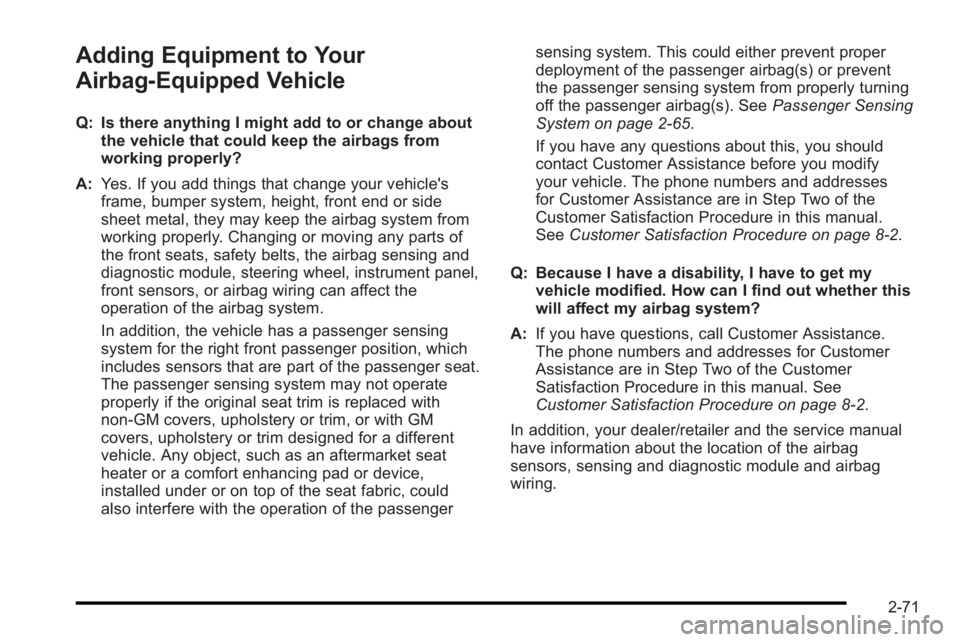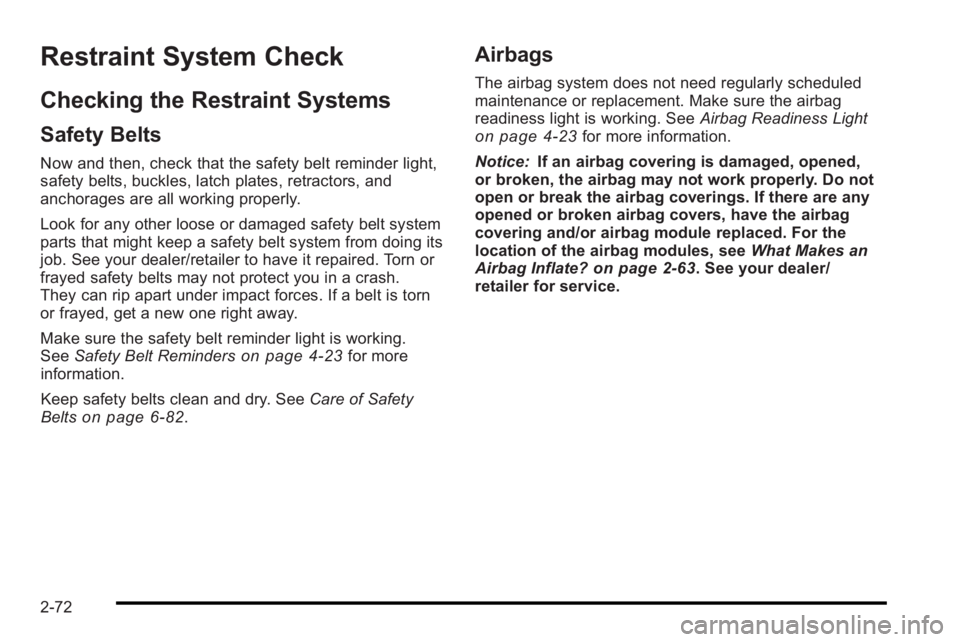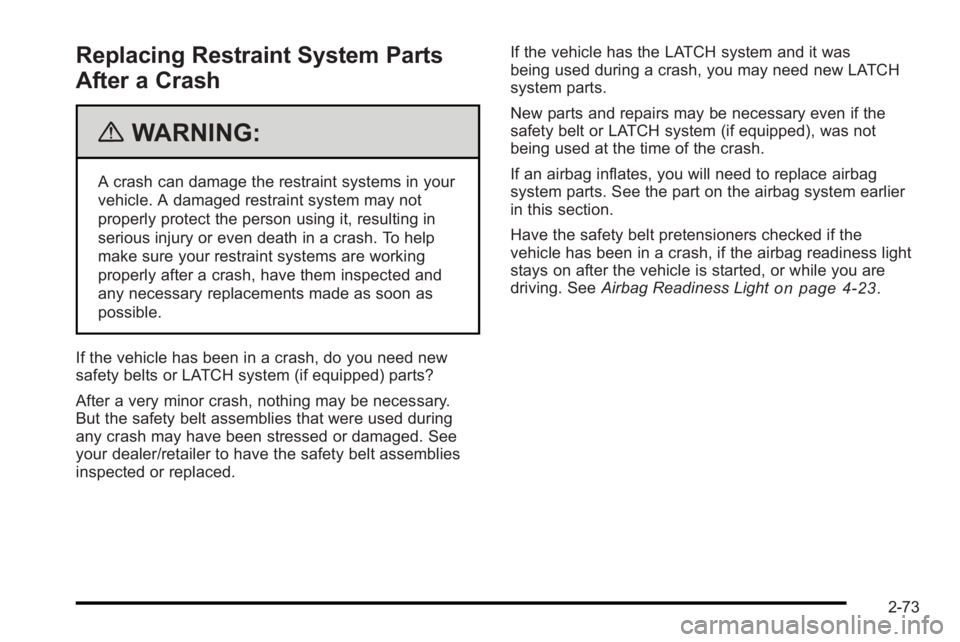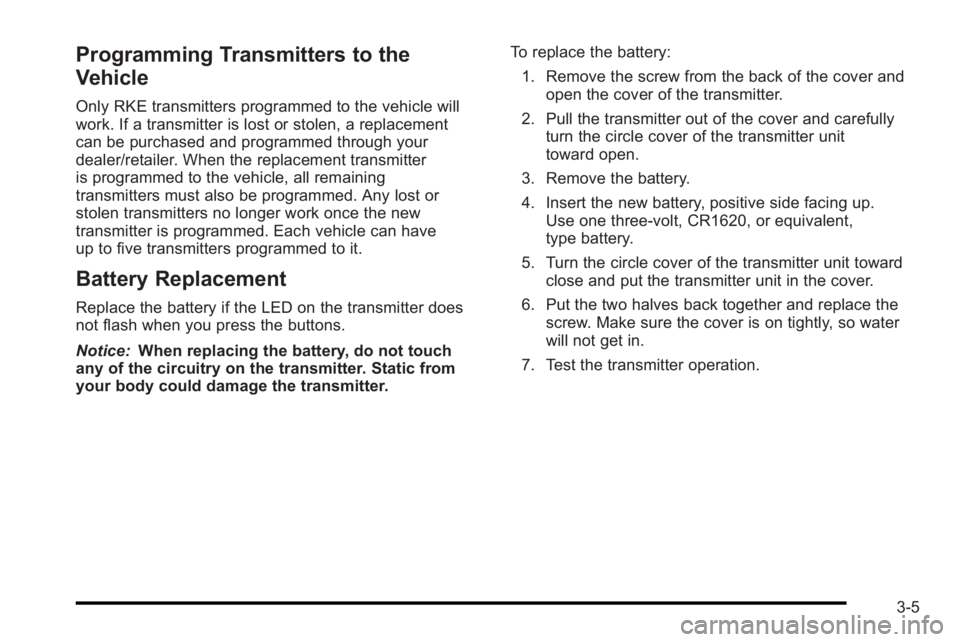PONTIAC G3 2010 Owners Manual
Manufacturer: PONTIAC, Model Year: 2010, Model line: G3, Model: PONTIAC G3 2010Pages: 368, PDF Size: 3.94 MB
Page 101 of 368

Adding Equipment to Your
Airbag-Equipped Vehicle
Q: Is there anything I might add to or change aboutthe vehicle that could keep the airbags from
working properly?
A: Yes. If you add things that change your vehicle's
frame, bumper system, height, front end or side
sheet metal, they may keep the airbag system from
working properly. Changing or moving any parts of
the front seats, safety belts, the airbag sensing and
diagnostic module, steering wheel, instrument panel,
front sensors, or airbag wiring can affect the
operation of the airbag system.
In addition, the vehicle has a passenger sensing
system for the right front passenger position, which
includes sensors that are part of the passenger seat.
The passenger sensing system may not operate
properly if the original seat trim is replaced with
non-GM covers, upholstery or trim, or with GM
covers, upholstery or trim designed for a different
vehicle. Any object, such as an aftermarket seat
heater or a comfort enhancing pad or device,
installed under or on top of the seat fabric, could
also interfere with the operation of the passenger sensing system. This could either prevent proper
deployment of the passenger airbag(s) or prevent
the passenger sensing system from properly turning
off the passenger airbag(s). See
Passenger Sensing
System on page 2‑65.
If you have any questions about this, you should
contact Customer Assistance before you modify
your vehicle. The phone numbers and addresses
for Customer Assistance are in Step Two of the
Customer Satisfaction Procedure in this manual.
See Customer Satisfaction Procedure on page 8‑2.
Q: Because I have a disability, I have to get my vehicle modified. How can I find out whether this
will affect my airbag system?
A: If you have questions, call Customer Assistance.
The phone numbers and addresses for Customer
Assistance are in Step Two of the Customer
Satisfaction Procedure in this manual. See
Customer Satisfaction Procedure on page 8‑2.
In addition, your dealer/retailer and the service manual
have information about the location of the airbag
sensors, sensing and diagnostic module and airbag
wiring.
2-71
Page 102 of 368

Restraint System Check
Checking the Restraint Systems
Safety Belts
Now and then, check that the safety belt reminder light,
safety belts, buckles, latch plates, retractors, and
anchorages are all working properly.
Look for any other loose or damaged safety belt system
parts that might keep a safety belt system from doing its
job. See your dealer/retailer to have it repaired. Torn or
frayed safety belts may not protect you in a crash.
They can rip apart under impact forces. If a belt is torn
or frayed, get a new one right away.
Make sure the safety belt reminder light is working.
SeeSafety Belt Reminders
on page 4‑23for more
information.
Keep safety belts clean and dry. See Care of Safety
Belts
on page 6‑82.
Airbags
The airbag system does not need regularly scheduled
maintenance or replacement. Make sure the airbag
readiness light is working. See Airbag Readiness Light
on page 4‑23for more information.
Notice: If an airbag covering is damaged, opened,
or broken, the airbag may not work properly. Do not
open or break the airbag coverings. If there are any
opened or broken airbag covers, have the airbag
covering and/or airbag module replaced. For the
location of the airbag modules, see What Makes an
Airbag Inflate?
on page 2‑63. See your dealer/
retailer for service.
2-72
Page 103 of 368

Replacing Restraint System Parts
After a Crash
{WARNING:
A crash can damage the restraint systems in your
vehicle. A damaged restraint system may not
properly protect the person using it, resulting in
serious injury or even death in a crash. To help
make sure your restraint systems are working
properly after a crash, have them inspected and
any necessary replacements made as soon as
possible.
If the vehicle has been in a crash, do you need new
safety belts or LATCH system (if equipped) parts?
After a very minor crash, nothing may be necessary.
But the safety belt assemblies that were used during
any crash may have been stressed or damaged. See
your dealer/retailer to have the safety belt assemblies
inspected or replaced. If the vehicle has the LATCH system and it was
being used during a crash, you may need new LATCH
system parts.
New parts and repairs may be necessary even if the
safety belt or LATCH system (if equipped), was not
being used at the time of the crash.
If an airbag inflates, you will need to replace airbag
system parts. See the part on the airbag system earlier
in this section.
Have the safety belt pretensioners checked if the
vehicle has been in a crash, if the airbag readiness light
stays on after the vehicle is started, or while you are
driving. See
Airbag Readiness Light
on page 4‑23.
2-73
Page 104 of 368

2NOTES
2-74
Page 105 of 368

Section 3 Features and Controls
Keys. . . . . . . . . . . . . . . . . . . . . . . . . . . . . . . . . . . . . . . . . . . . . . . . 3-2
Remote Keyless Entry (RKE) System . . . . . . . . . . . 3-3
Remote Keyless Entry (RKE) System Operation . . . . . . . . . . . . . . . . . . . . . . . . . . . . . . . . . . . . . 3-4
Doors and Locks . . . . . . . . . . . . . . . . . . . . . . . . . . . . . . . . . . 3-6
Door Locks . . . . . . . . . . . . . . . . . . . . . . . . . . . . . . . . . . . . . 3-6
Central Door Unlocking System . . . . . . . . . . . . . . . . . 3-7
Door Ajar Reminder . . . . . . . . . . . . . . . . . . . . . . . . . . . . . 3-7
Rear Door Security Locks . . . . . . . . . . . . . . . . . . . . . . . 3-7
Trunk . . . . . . . . . . . . . . . . . . . . . . . . . . . . . . . . . . . . . . . . . . . 3-8
Liftgate (Hatchback) . . . . . . . . . . . . . . . . . . . . . . . . . . . 3-11
Windows . . . . . . . . . . . . . . . . . . . . . . . . . . . . . . . . . . . . . . . . . . 3-12
Manual Windows . . . . . . . . . . . . . . . . . . . . . . . . . . . . . . 3-13
Power Windows . . . . . . . . . . . . . . . . . . . . . . . . . . . . . . . 3-13
Sun Visors . . . . . . . . . . . . . . . . . . . . . . . . . . . . . . . . . . . . . 3-14
Theft-Deterrent Systems . . . . . . . . . . . . . . . . . . . . . . . . .3-14
Immobilizer . . . . . . . . . . . . . . . . . . . . . . . . . . . . . . . . . . . . 3-14
Immobilizer Operation . . . . . . . . . . . . . . . . . . . . . . . . . 3-14
Content Theft-Deterrent . . . . . . . . . . . . . . . . . . . . . . . . 3-15
Starting and Operating Your Vehicle . . . . . . . . . . . .3-17
New Vehicle Break-In . . . . . . . . . . . . . . . . . . . . . . . . . . 3-17
Ignition Positions . . . . . . . . . . . . . . . . . . . . . . . . . . . . . . 3-18 Starting the Engine . . . . . . . . . . . . . . . . . . . . . . . . . . . . 3-19
Engine Heater . . . . . . . . . . . . . . . . . . . . . . . . . . . . . . . . . 3-20
Automatic Transmission Operation . . . . . . . . . . . . . 3-22
Manual Transmission Operation . . . . . . . . . . . . . . . 3-26
Parking Brake . . . . . . . . . . . . . . . . . . . . . . . . . . . . . . . . . 3-28
Shifting Into Park (Automatic Transmission) . . . 3-29
Shifting Out of Park . . . . . . . . . . . . . . . . . . . . . . . . . . . . 3-30
Parking the Vehicle (Manual Transmission) . . . . 3-31
Parking Over Things That Burn . . . . . . . . . . . . . . . . 3-32
Engine Exhaust . . . . . . . . . . . . . . . . . . . . . . . . . . . . . . . . 3-32
Running the Vehicle While Parked . . . . . . . . . . . . . 3-33
Mirrors . . . . . . . . . . . . . . . . . . . . . . . . . . . . . . . . . . . . . . . . . . . . 3-34
Manual Rearview Mirror . . . . . . . . . . . . . . . . . . . . . . . . 3-34
Outside Manual Mirrors . . . . . . . . . . . . . . . . . . . . . . . . 3-34
Outside Power Mirrors . . . . . . . . . . . . . . . . . . . . . . . . . 3-35
Outside Convex Mirror . . . . . . . . . . . . . . . . . . . . . . . . . 3-35
Outside Heated Mirrors . . . . . . . . . . . . . . . . . . . . . . . . 3-35
Storage Areas . . . . . . . . . . . . . . . . . . . . . . . . . . . . . . . . . . . . 3-36
Glove Box . . . . . . . . . . . . . . . . . . . . . . . . . . . . . . . . . . . . . 3-36
Cupholders . . . . . . . . . . . . . . . . . . . . . . . . . . . . . . . . . . . . 3-36
Sunroof . . . . . . . . . . . . . . . . . . . . . . . . . . . . . . . . . . . . . . . . . . . 3-37
3-1
Page 106 of 368

Keys
{WARNING:
Leaving children in a vehicle with the ignition key
is dangerous for many reasons, children or others
could be badly injured or even killed. They could
operate the power windows or other controls or
even make the vehicle move. The windows will
function with the keys in the ignition and children
could be seriously injured or killed if caught in the
path of a closing window. Do not leave the keys in
a vehicle with children.
The key can be used for the ignition, doors and all
other locks.
The key has a key code tag that the dealer/retailer or
qualified locksmith can use to make new keys. Store
this information in a safe place, not in your vehicle.
3-2
Page 107 of 368

Your vehicle may have an electronic immobilizer
designed to protect your car against theft. If so, only
keys with the correct electronic code can be used to
start the vehicle. SeeImmobilizer Operation
on
page 3‑14for additional information. If a replacement
key or an additional key is needed, it must be
purchased from your dealer/retailer or certified
locksmith.
Notice: If you ever lock your keys in the vehicle,
you may have to damage the vehicle to get in.
Be sure you have spare keys.
In an emergency, contact Roadside Assistance.
See Roadside Assistance Program
on page 8‑6for more information.
Remote Keyless Entry (RKE) System
SeeRadio Frequency Statementon page 8‑17for
information regarding Part 15 of the Federal
Communications Commission (FCC) Rules and
RSS-210/211 of Industry and Science Canada.
Changes or modifications to this system by other than
an authorized service facility could void authorization to
use this equipment.
If there is a decrease in the RKE operating range,
try this:
.Check the distance. The transmitter may be too far
from the vehicle. Stand closer during rainy or
snowy weather.
.Check the location. Other vehicles or objects may
be blocking the signal. Take a few steps to the left
or right, hold the transmitter higher, and try again.
.Check the transmitter's battery. See “Battery
Replacement” later in this section.
.If the transmitter is still not working correctly,
see your dealer/retailer or a qualified technician
for service.
3-3
Page 108 of 368

Remote Keyless Entry (RKE) System
Operation
The Remote Keyless Entry (RKE) transmitter functions
work up to 65 feet (20 m) away from the vehicle.
There are other conditions which can affect the
performance of the transmitter. SeeRemote Keyless
Entry (RKE) System on page 3‑3.
HatchbackSedan The following functions may be available if the vehicle
has RKE:
Q(Lock):
Press to lock all of the doors. If all of the
doors and the trunk or liftgate are closed, the hazard
lamps flash once and the horn will sound to indicate
that locking has occurred and the theft-deterrent system
is active.
K(Unlock): Press to unlock all of the doors. The
hazard lamps flash twice to indicate that unlocking has
occurred and that the theft-deterrent system is
deactivated. If the doors are not opened within
30 seconds the doors will lock again.
3(Panic) (Hatchback): Press to sound the panic
alarm. The hazard lamps will flash and the panic alarm
will stay on for about 30 seconds. Press any of the
buttons on the transmitter to turn off the alarm.
V(Remote Trunk Release) (Sedan): Press and
hold for approximately one second to open the trunk.
The LED light (A) on the transmitter flashes when the
buttons on the transmitter are pressed. If the light does
not flash see “Battery Replacement” later in this section.
The buttons do not operate and the theft-deterrent
system does not activate if the key is in the ignition.
3-4
Page 109 of 368

Programming Transmitters to the
Vehicle
Only RKE transmitters programmed to the vehicle will
work. If a transmitter is lost or stolen, a replacement
can be purchased and programmed through your
dealer/retailer. When the replacement transmitter
is programmed to the vehicle, all remaining
transmitters must also be programmed. Any lost or
stolen transmitters no longer work once the new
transmitter is programmed. Each vehicle can have
up to five transmitters programmed to it.
Battery Replacement
Replace the battery if the LED on the transmitter does
not flash when you press the buttons.
Notice:When replacing the battery, do not touch
any of the circuitry on the transmitter. Static from
your body could damage the transmitter. To replace the battery:
1. Remove the screw from the back of the cover and open the cover of the transmitter.
2. Pull the transmitter out of the cover and carefully turn the circle cover of the transmitter unit
toward open.
3. Remove the battery.
4. Insert the new battery, positive side facing up. Use one three-volt, CR1620, or equivalent,
type battery.
5. Turn the circle cover of the transmitter unit toward close and put the transmitter unit in the cover.
6. Put the two halves back together and replace the screw. Make sure the cover is on tightly, so water
will not get in.
7. Test the transmitter operation.
3-5
Page 110 of 368

Doors and Locks
Door Locks
{WARNING:
Unlocked doors can be dangerous.
.Passengers, especially children, can easily
open the doors and fall out of a moving
vehicle. When a door is locked, the handle will
not open it. The chance of being thrown out of
the vehicle in a crash is increased if the doors
are not locked. So, all passengers should
wear safety belts properly and the doors
should be locked whenever the vehicle is
driven.
.Young children who get into unlocked vehicles
may be unable to get out. A child can be
overcome by extreme heat and can suffer
permanent injuries or even death from heat
stroke. Always lock the vehicle whenever
leaving it.(Continued)
WARNING: (Continued)
.Outsiders can easily enter through an
unlocked door when you slow down or stop
your vehicle. Locking your doors can help
prevent this from happening.
There are several ways to lock and unlock the vehicle.
From the outside, use your key or the Remote Keyless
Entry (RKE) transmitter. See Remote Keyless Entry
(RKE) System Operation on page 3‑4.
To manually unlock the front doors from the outside,
insert the key and turn it counterclockwise. To manually
lock the doors, insert the key and turn it clockwise.
All doors, except for the driver door, can be locked by
pushing down the manual door lock and then closing
the door. On vehicles with power locks, the driver door
can only by locked from the outside by using the key or
the optional RKE transmitter.
From the inside, all of the doors can be locked and
unlocked by pushing or pulling the manual door lock
located on each door.
3-6